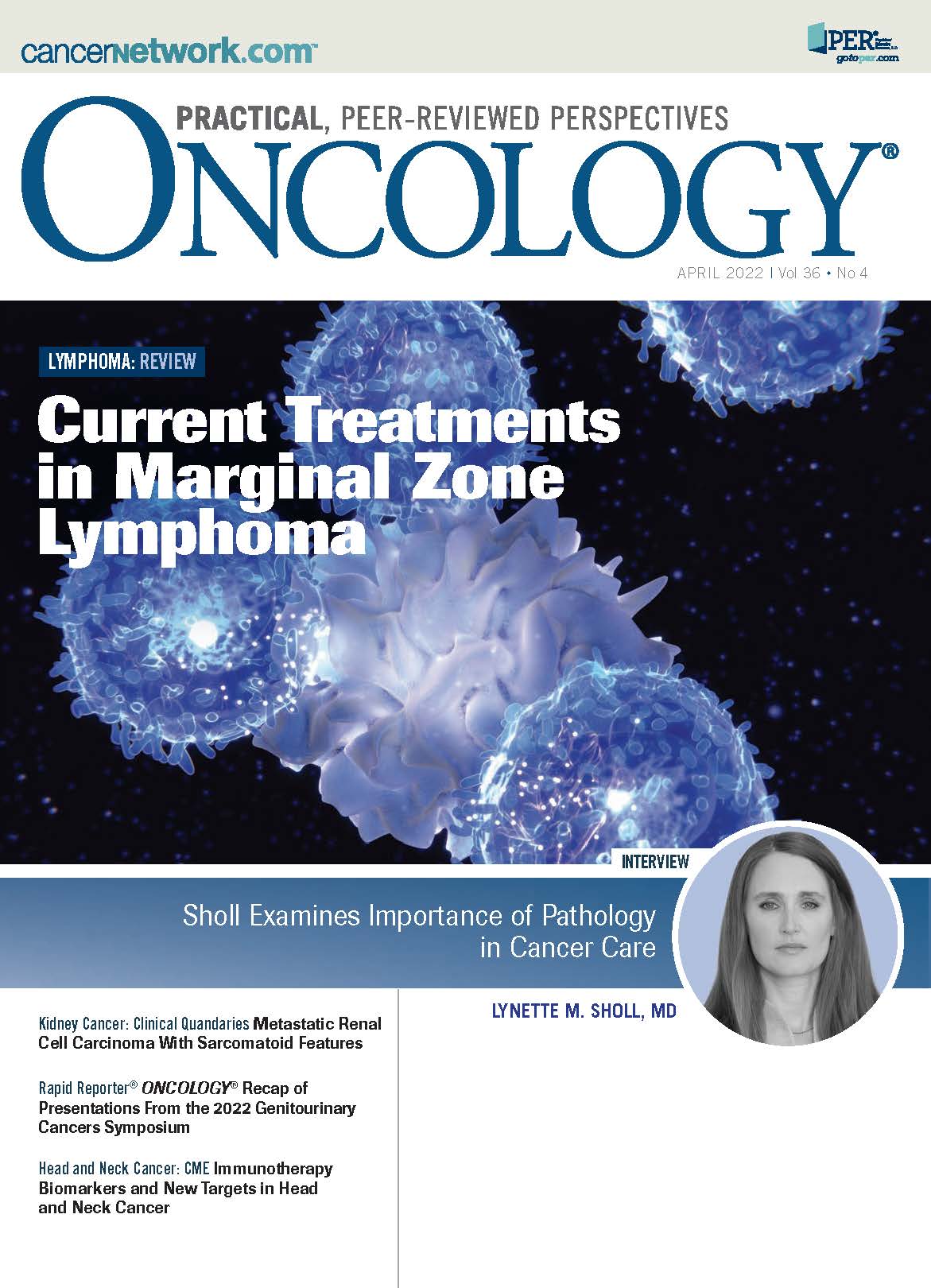Metastatic Renal Cell Carcinoma With Sarcomatoid Features
In this installement of Clinical Quandaries, Abigail Mateos-Soria, MD, and colleagues present a case of an 38-year-old woman who has a 3-month history of fatigue, dyspnea, significant weight loss, and severe left flank pain.
Oncology (Williston Park). 2022;36(4):221-225.
DOI: 10.46883/2022.25920955
A previously healthy woman, aged 38 years, presented with a 3-month history of fatigue, dyspnea on exertion, significant weight loss, and severe left flank pain; her symptoms restricted any work activities. Laboratory test results were notable for hypercalcemia (corrected serum calcium, 12.8 mg/dL), anemia (9.3 g/dL), and lactate dehydrogenase elevation (>1.5 times the upper limit of normal). A CT scan revealed a 14-cm left renal mass and multiple lung and mediastinal lymph node metastases (FIGURE 1A and 1B). A surgical open biopsy was performed; histopathological analysis concluded clear cell renal carcinoma (RCC) with 30% sarcomatoid features (Figure 2). The patient was diagnosed with International Metastatic Renal Cell Carcinoma Database Consortium (IMDC) poor-risk metastatic RCC with sarcomatoid features. She started first-line systemic treatment.
What is the best first-line systemic treatment for patients with metastatic clear cell RCC with sarcomatoid features?
FIGURE 1 CT Images Before (left) and After (right) Systemic Treatment Basal scan reveals multiple lung nodules with a diffuse distribution. The largest one (A) has a maximum diameter of 24 mm, and a heterogeneous mass in the upper pole of the left kidney (B). has a maximum diameter of 14 cm. Six months later, a follow-up CT scan shows a partial response: The largest lung nodule (C). now has a diameter of 2 mm, and the renal mass (D). has been reduced to 85 mm.
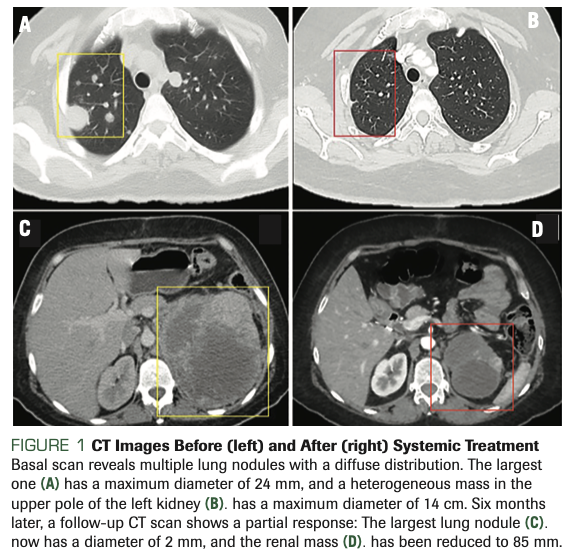
FIGURE 2. Histopathologic Evaluation of the Renal Mass
Compact nests and sheets of cells with clear cytoplasm, consistent with clear cell renal cell carcinoma (A) pleomorphic and spindle cells with high cellularity and atypia, compatible with sarcomatoid dedifferentiation (B)
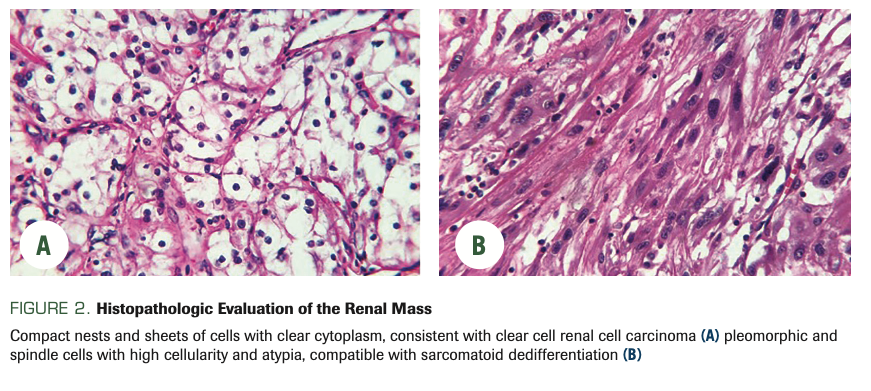
Discussion
Sarcomatoid differentiation is a rare transformation that may occur in any type of RCC: About 5% of all RCCs and 20% of all metastatic RCCs have sarcomatoid features.1 Sarcomatoid RCC (sRCC) predicts a poor prognosis. Patients present with metastatic disease in 77% of cases; even in initially localized cases, 72% will have recurrences, with a median time to recurrence of 26 months.2,3 Despite the advances in systemic treatments, the median overall survival (OS) of patients with sRCC was about 10 to 13 months up until the immunotherapy era.4,5
The microscopic hallmark of sRCC is the sarcoma-like tumor: spindle cells with high cellularity and atypia coexisting with the epithelial component. The presence of any percentage of sarcomatoid differentiation establishes the diagnosis of sRCC.6 Sarcomatoid features are more likely to be found in nephrectomy specimens: In a retrospective series of patients with metastatic RCC who underwent percutaneous primary tumor biopsy before cytoreductive nephrectomy, sarcomatoid elements were identified preoperatively in only 11.8% of cases.7 There is evidence that the sarcomatoid component shares the same clonal origin with the epithelial RCC component, then develops at a later stage of tumorigenesis through the epithelial-mesenchymal transition.1,8 Mutations that are present at a higher degree in the sarcomatoid component include TP53, NF2, BAP1, and ARID1A; sRCC harbors a significantly higher mutational burden compared with the epithelial RCC component.8,9
The immune microenvironment of sRCC also exhibits important particularities: Compared with the non-sRCC component, sRCC has a higher PD-L1 expression in cancer cells and a higher density of tumor-infiltrating lymphocytes.9 This finding provided the rationale to evaluate immune checkpoint inhibition (ICI) in sRCC.
Treatment of sRCC mirrors that of the non-sRCC component and has been a challenge due to the nature of the sarcomatoid dedifferentiation and ineffectiveness of systemic therapies. Key studies regarding different types of treatments for sRCC are depicted in Table 1. Chemotherapeutic agents were used to treat sRCC in the 1990s and early 2000s, attempting to control the high proliferative nature of this disease.10 Doxorubicin and gemcitabine combinations were mostly used, with poor outcomes.10-13 In a phase 2 study of doxorubicin plus ifosfamide, clinical responses were not observed, with median progression-free survival (PFS) and OS of 2.2 and 3.9 months, respectively.11 In another phase 2 study of doxorubicin plus gemcitabine, a 16% response rate was documented, with a median PFS of 3.5 months and OS of 8.8 months.13 Altogether, responses were scarce and short-lived; contemporary guidelines do not include chemotherapy as a treatment option for sRCC. Therefore, answer (A) is incorrect.
TABLE 1 Studies of Chemotherapy and Targeted Therapy in sRCC
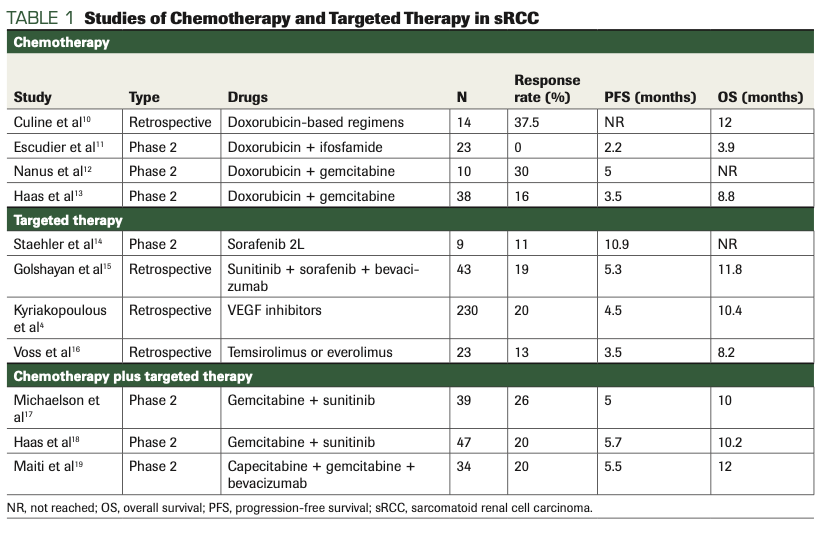
The development of vascular endothelial vascular receptor (VEGFR)–targeted therapies in the early 2000s that were shown to be effective in metastatic RCC provided hope for the treatment of sRCC. A prospective, open-label study investigated sorafenib (Nexavar) in 9 patients with sRCC and disease progression after chemotherapy with doxorubicin plus gemcitabine: Subsequent antiangiogenic treatment with sorafenib resulted in additional progression-free survival in 5 of 9 patients with a median time to progression of 10.9 months (range, 0.6-25.5).14 In a retrospective study of 43 patients with sRCC who were treated with various VEGFR-targeted therapies including sorafenib, bevacizumab (Avastin), and sunitinib (Sutent), the median PFS was 5.3 months and the median OS was 11.8 months. Partial responses (PRs) were achieved in 19% of patients and no complete responses (CRs) were seen. Interestingly, the percentage of sarcomatoid differentiation appears to have a prognostic value: Patients with less than 20% sarcomatoid elements in the primary tumor (as compared with patients with 20% or greater sarcomatoid elements) had better tumor shrinkage percentages (–7% vs +10%) and response rates (33% vs 0% PRs); nonsignificant trends in better PFS and OS were also seen.15 A subgroup analysis of 230 patients from the IMDC during the targeted therapy era, in which 78% were treated with sunitinib, reported a 21% response rate and median PFS and OS of 4.5 and 10.4 months, respectively.4 Mammalian Targets of Rapamycin (mTOR) inhibitors achieved similar PFS (median, 3.5 months) and OS (median, 8.2 months) compared with other targeted therapies.16 Overall, although targeted monotherapy is an acceptable first-line treatment in some patients with RCC, it is mostly ineffective in sRCC, especially when a greater percentage of sarcomatoid features is present.15,16
The combination of chemotherapy and targeted therapies was evaluated to potentially improve outcomes in sRCC. A phase 2 trial (NCT01164228) of
39 patients with sRCC receiving sunitinib plus gemcitabine showed a median PFS of 5 months and median OS of 10 months.17 The phase 2 E1808 study (NCT01164228) was a pivotal trial randomizing patients to the combination of sunitinib and gemcitabine vs sunitinib alone; overall response rate (ORR; 20.0% vs 11.1%), median PFS (23 vs 13 weeks), and median OS (41 vs 33 weeks) all favored the combination arm.18 Another retrospective study evaluating the combination of capecitabine, bevacizumab, and gemcitabine in 34 patients with metastatic sRCC resulted in a median PFS of 5.5 months and median OS of 12 months. ORR was poor at 20% and the incidence of serious toxicities was high (rash in 24%, thrombosis in 6%).19 The combination of chemotherapy plus a TKI is toxic and does not significantly improve outcomes for sRCC. Therefore, answer (B) is incorrect.
Immunotherapy has changed the therapeutic landscape for RCC. The combination of dual ICI or ICI plus a TKI are both considered standard first-line treatments in clear cell RCC, with several treatment combinations available in 2022.20 RCC is a highly immunogenic tumor, and sRCC appears to have even higher PD-L1 expression and tumor-infiltrating lymphocytes than non-sRCC.8 Consistent with the aforementioned data, several phase 3 trials have performed subset analyses for patients with sRCC with impressive results; although post hoc and exploratory in nature, their findings constitute the first clinically meaningful improvement in sRCC survival in decades.9,20
The phase 3 CheckMate 214 clinical trial (NCT02231749) demonstrated the superiority of the dual immunotherapy combination of nivolumab plus ipilimumab vs sunitinib in patients with IMDC intermediate-/poor-risk RCC.21 Among all 1096 patients who underwent randomization, 145 (13.2%) had sarcomatoid features upon central or local histopathological examination; 139 were classified as IMDC intermediate/poor risk and 6 as favorable risk. In a post hoc analysis of the 139 intermediate-/poor-risk sRCC patients, median OS was not reached (NR) for the nivolumab/ipilimumab arm vs 14.2 months for sunitinib (HR, 0.45; 95% CI, 0.3-0.7; P = .0004). Median PFS was 26.5 months vs 5.1 months, respectively (HR, 0.54; 95% CI, 0.33-0.86; P = .0093). Confirmed ORR was 60.8% with nivolumab/ipilimumab compared with 23.1% with sunitinib, with CR rates of 18.9% and 3.1%, respectively. It is important to note that the CR, ORR, PFS, and OS rate benefits among the patients with sRCC were noticeably better than those achieved in the intent-to-treat population.22
Besides dual ICI, several ICI plus anti-VEGF combinations have shown clinical improvements in sRCC in the first-line setting. Subset analyses from the phase 3 JAVELIN Renal 101 trial (NCT02684006) of avelumab (Bavencio) plus axitinib (Inlyta), and from the phase 3 IMmotion151 clinical trial (NCT02420821) of atezolizumab (Tecentriq) plus bevacizumab, both support these combinations in sRCC. In JAVELIN Renal 101, 108 patients (12.2%) had sRCC; avelumab plus axitinib vs sunitinib improved PFS (median, 7.0 months vs 4.0 months, respectively), ORR (46.8% vs 21.3%), and CR rate (4.3% vs 0%).23 In IMmotion151, among 142 patients (16%) with sRCC, atezolizumab plus bevacizumab vs sunitinib improved PFS (median, 8.3 months vs 5.3 months, respectively) OS (NR vs 15.0 months), ORR (49% vs 14%), and CR rate (10% vs 3%).24 These results should be viewed with caution, however, as OS was not improved in the intent-to-treat population of those studies, and other immunotherapy plus anti-VEGF combinations are available with more consistent results.
One such combination is pembrolizumab (Keytruda) plus axitinib, studied in the phase 3 KEYNOTE-426 trial (NCT02853331), which demonstrated the significant benefit of the combination over sunitinib in RCC.25 Among 861 randomized patients, 104 (12.1%) had sRCC; in this subgroup, pembrolizumab plus axitinib improved several outcomes over sunitinib: OS (12-month rate, 83.4% vs 79.5%, respectively; HR, 0.58), PFS (median, NR vs 8.4 months; HR, 0.54), ORR (58.8% vs 31.5%), and CR rate (11.8% vs 0%).26 More recently, results from the CheckMate 9ER trial (NCT03141177) confirmed the superiority of the nivolumab and cabozantinib (Cabometyx) combination over sunitinib in the overall population.27 In this study, 75 of the 651 randomized patients (11.5%) had sRCC. Consistent with the results in the whole population, at a median follow-up of 18.1 months, there was an improvement in OS with nivolumab plus cabozantinib over sunitinib (median, NR vs 19.7 months, respectively), PFS (median, 10.9 months vs 4.2 months), ORR (55.9% vs 22.0%), and CR rate (8.8% vs 2.4%). It is important to note that the magnitude of benefit for the combination in the sRCC population was greater than in the non-sRCC population (HR for PFS, 0.42 vs 0.56; HR for OS, 0.36 vs 0.73), favoring nivolumab plus cabozantinib as an alternative for this population.28 Further follow-up is required to confirm the aforementioned advantages.
The recently published results of the CLEAR trial (NCT02811861) demonstrated that the combination of lenvatinib (Lenvima) and pembrolizumab was associated with better PFS and OS than both the lenvatinib plus everolimus (Afinitor) combination or sunitinib arms. The post hoc analysis of the sarcomatoid subgroup has not been published; however, in the main publication’s forest plot subgroup analysis, sRCC appears to benefit, at least in PFS.29 Table 2 shows the comparisons in outcomes among the different dual ICI or ICI plus anti-VEGF combinations.
TABLE 2 Trials of Immune Checkpoint Inhibitors for sRCC
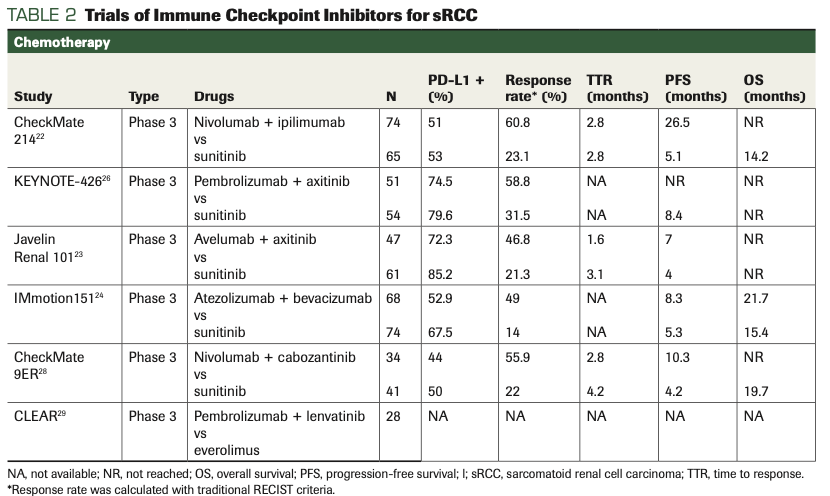
The choice of therapy in patients with sRCC should follow the path of those with non-sRCC. Parameters to consider in the initial decision include performance status, IMDC risk group, PD-L1 status, contraindication to immunotherapy, and the need to obtain a rapid response.30
Thus, answer (E) turns out to be the correct choice since both (C) the combination of dual immunotherapy or (D) immunotherapy with a TKI are acceptable choices for the first-line treatment of patients with sRCC.
Outcome of This Case
Nivolumab plus cabozantinib was started in this patient. After 6 months of treatment, the patient had a PR (60%) according to RECIST 1.1 criteria (Figure 2). Currently, the patient has an excellent performance status without toxicities. She remains on treatment and has a PFS of 24 months. The results of her last CT scan indicated that she continued to have a 54% PR.
AUTHOR AFFILIATIONS:
Abigail Mateos-Soria, MD1; Francisco J. Castro-Alonso, MD2; Yusuf Z. Şener, MD3; Gabriel Quintero-Bustos, MD4; Mariana Licano-Zubiate, MD5; Rene Bourlon, MD6; Elaine T. Lam, MD7; Maria T. Bourlon, MD, MSc8
1Hematology and Oncology Department, Instituto Nacional de Ciencias Salvador Zubirán, Mexico City, Mexico
2Internal Medicine Department, Hospital Regional de Alta Epecialidad de Oaxaca, Oaxaca, Mexico
3Internal Medicine and Cardiology Department, Beypazarı State Hospital, Ankara, Turkey
4Pathology Department, Instituto Nacional de Ciencias Salvador Zubirán, Mexico City, Mexico
5Radiology Department, Instituto Nacional de Ciencias Salvador Zubirán, Mexico City, Mexico
6Hospital Angeles del Pedregal, Mexico City, Mexico
7Department of Medicine, University of Colorado – Anschutz Medical Campus, Aurora, Colorado
8Hematology and Oncology Department, Instituto Nacional de Ciencias Medicas y Nutricion Salvador Zubirán, Mexico City, Mexico
References
- Blum KA, Gupta S, Tickoo SK, et al. Sarcomatoid renal cell carcinoma: biology, natural history and management. Nat Rev Urol. 2020;17(12):659-678. doi:10.1038/s41585-020-00382-9
- Mian BM, Bhadkamkar N, Slaton JW, et al. Prognostic factors and survival of patients with sarcomatoid renal cell carcinoma. J Urol. 2002;167(1):65-70.
- Merrill MM, Wood CG, Tannir NM, et al. Clinically nonmetastatic renal cell carcinoma with sarcomatoid dedifferentiation: natural history and outcomes after surgical resection with curative intent. Urol Oncol. 2015;33(4):166.e21-e29. doi:10.1016/j.urolonc.2014.11.021
- Kyriakopoulos CE, Chittoria N, Choueiri TK, et al. Outcome of patients with metastatic sarcomatoid renal cell carcinoma: results from the International Metastatic Renal Cell Carcinoma Database Consortium. Clin Genitourin Cancer. 2015;13(2):e79-e85. doi:10.1016/j.clgc.2014.08.011
- Korenbaum C, Pierard L, Thiéry A, et al. Treatments, outcomes, and validity of prognostic scores in patients with sarcomatoid renal cell carcinoma: a 20-year single-institution experience. Clin Genitourin Cancer. 2018;16(3):e577-e586. doi:10.1016/j.clgc.2017.12.005
- Shuch B, Bratslavsky G, Linehan WM, Srinivasan R. Sarcomatoid renal cell carcinoma: a comprehensive review of the biology and current treatment strategies. Oncologist. 2012;17(1):46-54. doi:10.1634/theoncologist.2011-0227
- Abel EJ, Culp SH, Matin SF, et al. Percutaneous biopsy of primary tumor in metastatic renal cell carcinoma to predict high risk pathological features: comparison with nephrectomy assessment. J Urol. 2010;184(5):1877-1881. doi:10.1016/j.juro.2010.06.105
- Bi M, Zhao S, Said JW, et al. Genomic characterization of sarcomatoid transformation in clear cell renal cell carcinoma. Proc Natl Acad Sci U S A. 2016;113(8):2170-2175. doi:10.1073/pnas.1525735113
- Debien V, Thouvenin J, Lindner V, et al. Sarcomatoid dedifferentiation in renal cell carcinoma: from novel molecular insights to new clinical opportunities. Cancers (Basel). 2019;12(1):99. doi:10.3390/cancers12010099
- Culine S, Bekradda M, Terrier-Lacombe MJ, Droz JP. Treatment of sarcomatoid renal cell carcinoma: is there a role for chemotherapy? Eur Urol. 1995;27(2):138-141. doi:10.1159/000475145
- Escudier B, Droz JP, Rolland F, et al; Genitourinary Group of the French Federation of Cancer Centers. Doxorubicin and ifosfamide in patients with metastatic sarcomatoid renal cell carcinoma: a phase II study of the Genitourinary Group of the French Federation of Cancer Centers. J Urol. 2002;168(3):959-961. doi:10.1097/01.ju.0000026902.77397.fd
- Nanus DM, Garino A, Milowsky MI, Larkin M, Dutcher JP. Active chemotherapy for sarcomatoid and rapidly progressing renal cell carcinoma. Cancer. 2004;101(7):1545-1551. doi:10.1002/cncr.20541
- Haas NB, Lin X, Manola J, et al. A phase II trial of doxorubicin and gemcitabine in renal cell carcinoma with sarcomatoid features: ECOG 8802. Med Oncol. 2012;29(2):761-767. doi:10.1007/s12032-011-9829-8
- Staehler M, Haseke N, Roosen A, et al. Sorafenib after combination therapy with gemcitabine plus doxorubicin in patients with sarcomatoid renal cell carcinoma: a prospective evaluation. Eur J Med Res. 2010;15(7):287-291. doi:10.1186/2047-783x-15-7-287
- Golshayan AR, George S, Heng DY, et al. Metastatic sarcomatoid renal cell carcinoma treated with vascular endothelial growth factor-targeted therapy. J Clin Oncol. 2009;27(2):235-241. doi:10.1200/JCO.2008.18.0000
- Voss MH, Bastos DA, Karlo CA, et al. Treatment outcome with mTOR inhibitors for metastatic renal cell carcinoma with nonclear and sarcomatoid histologies. Ann Oncol. 2014;25(3):663-668. doi:10.1093/annonc/mdt578
- Michaelson MD, McKay RR, Werner L, et al. Phase 2 trial of sunitinib and gemcitabine in patients with sarcomatoid and/or poor-risk metastatic renal cell carcinoma. Cancer. 2015;121(19):3435-3443. doi:10.1002/cncr.29503
- Haas NB, Lin X, Manola J, et al. A phase II trial of doxorubicin and gemcitabine in renal cell carcinoma with sarcomatoid features: ECOG 8802. Med Oncol. 2012;29(2):761-767. doi:10.1007/s12032-011-9829-8
- Maiti A, Nemati-Shafaee M, Msaouel P, et al. Phase 2 trial of capecitabine, gemcitabine, and bevacizumab in sarcomatoid renal-cell carcinoma. Clin Genitourin Cancer. Published online August 10, 2017. doi:10.1016/j.clgc.2017.07.028
- Deleuze A, Saout J, Dugay F, et al. Immunotherapy in renal cell carcinoma: the future is now. Int J Mol Sci. 2020;21(7):2532. doi:10.3390/ijms21072532
- Albiges L, Tannir NM, Burotto M, et al. Nivolumab plus ipilimumab versus sunitinib for first-line treatment of advanced renal cell carcinoma: extended 4-year follow-up of the phase III CheckMate 214 trial. ESMO Open. 2020;5(6):e001079. doi:10.1136/esmoopen-2020-001079
- Tannir NM, Signoretti S, Choueiri TK, et al. Efficacy and safety of nivolumab plus ipilimumab versus sunitinib in first-line treatment of patients with advanced sarcomatoid renal cell carcinoma. Clin Cancer Res. 2021;27(1):78-86. doi:10.1158/1078-0432.CCR-20-2063
- Choueiri TK, Larkin JMG, Pal SK, et al. Efficacy and biomarker analysis of patients (pts) with advanced renal cell carcinoma (aRCC) with sarcomatoid histology (sRCC): subgroup analysis from the phase III JAVELIN renal 101 trial of first-line avelumab plus axitinib (A+Ax) vs sunitinib (S). Ann Oncol. 2019;30(suppl 5):abstr V361. doi:10.1093/annonc/mdz249.009
- Rini BI, Motzer RJ, Powles T, et al. Atezolizumab plus bevacizumab versus sunitinib for patients with untreated metastatic renal cell carcinoma and sarcomatoid features: a prespecified subgroup analysis of the IMmotion151 clinical trial. Eur Urol. 2021;79(5):659-662. doi:10.1016/j.eururo.2020.06.021
- Rini BI, Plimack ER, Stus V, et al; KEYNOTE-426 Investigators. Pembrolizumab plus axitinib versus sunitinib for advanced renal-cell carcinoma. N Engl J Med. 2019;380(12):1116-1127. doi:10.1056/NEJMoa1816714
- Rini BI, Plimack ER, Stus V, et al. Pembrolizumab (pembro) plus axitinib (axi) versus sunitinib as first-line therapy for metastatic renal cell carcinoma (mRCC): outcomes in the combined IMDC intermediate/poor risk and sarcomatoid subgroups of the phase 3 KEYNOTE-426 study. J Clin Oncol. 2019;37(suppl 15):abstr 4500. doi:10.1200/JCO.2019.37.15_suppl.4500
- Choueiri TK, Powles T, Burotto M, et al; CheckMate 9ER Investigators. Nivolumab plus cabozantinib versus sunitinib for advanced renal-cell carcinoma. N Engl J Med. 2021;384(9):829-841. doi:10.1056/NEJMoa2026982
- Motzer RJ, Choueiri TK, Powles T, et al. Nivolumab + cabozantinib (NIVO+CABO) versus sunitinib (SUN) for advanced renal cell carcinoma (aRCC): outcomes by sarcomatoid histology and updated trial results with extended follow-up of CheckMate 9ER. J Clin Oncol. 2021;39(suppl 6):abstr 308. doi:10.1200/JCO.2021.39.6_suppl.308
- Motzer R, Alekseev B, Rha S-Y, et al; CLEAR Trial Investigators. Lenvatinib plus pembrolizumab or everolimus for advanced renal cell carcinoma. N Engl J Med. 2021;384(14):1289-1300. doi:10.1056/NEJMoa2035716
- Aeppli S, Schmaus M, Eisen T, et al. First-line treatment of metastatic clear cell renal cell carcinoma: a decision-making analysis among experts. ESMO Open. 2021;6(1):100030. doi:10.1016/j.esmoop.2020.100030
